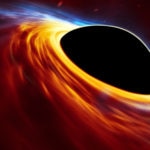Eight radio telescopes to photograph a black hole
The year the world says good bye to Stephen Hawking, one of the foremost authorities on black holes, might also be the year that one these massive cosmic voids is seen for the first time. Eight radio telescopes around the world have been linked up to take the first photograph of the black hole that sits in the center of our galaxy.

At a conference organized by the BBVA Foundation, Michael Kramer, director of the Max Planck Institute for Radio Astronomy explained how the radio telescopes that are part of the Event Horizon Telescope project dedicated hundreds of hours last year observing Sagittarius A*, with the goal of “taking a photo of this supermassive blackhole at the center of our galaxy.” Or, to be more exact, of its event horizon, the boundary of a black hole where the gravitational attraction is so strong not even light can escape.
This research will not reveal the mystery about what goes on inside a black hole, but it will facilitate the verification of some of Albert Einstein's predictions about the theory of gravity: “General relativity describes gravity as the warping of spacetime; in the center of the black hole spacetime warps too much, and physics and our mathematical models can't describe that state.” Kramer points out. “But it has been postulated that all black holes have to have an event horizon that blocks our vision to the interior of the hole, and it is the distance to the center of the black hole from which light cannot escape.”
Kramer is an expert at testing the Theory of General Relativity. The team of researchers at the Max Planck Institute have subjected it to their most demanding test to date, verifying that its predictions effectively describe one of the most difficult objects a human mind can imagine: a double pulsar.
“Pulsars,” Kramer explains, “are about the size of a city like Madrid, but they weigh 40% more than the sun.” They are dead stars that at one time exploded as supernovae. In this type of explosion, stars implode—they collapse upon themselves— and the result is a very dense dead star whose intense force of gravity can result in the formation of a black hole.
Pulsars are about the size of a city like Madrid, but they weigh 40% more than the sun.”
The precision of a pulsar’s rotation is so exact that those with millisecond intervals mark time better than human atomic clocks, which resulted in thoughts of extraterrestrial civilizations when they were first discovered in 1967.In this context, pulsars are the precursors to black holes: their force of gravity is very high, but not to such an extent that they swallow light. Pulsars also have their peculiarities. One is that they rotate rapidly, between dozens and thousands of times per second, while emitting a beam of radiation; every time one of these beams points to Earth, telescopes receive a pulse of energy, like a lighthouse.
Today some 1,800 pulsars have been identified, and it's known that many have companion objects rotating around them. In 2003, Kramer and other astrophysicists discovered one of these double pulsars only 1,500 light years away from Earth. Scientists immediately thought to use the discovery to subject the Theory of General Relativity to its most rigorous test yet, under conditions of intense gravity.
“In effect, we managed to conduct these tests only three years after the double pulsar's discovery.” Kramer explains. “Our results validated General Relativity with an accuracy of 0.05%, which is by far the greatest level of accuracy achieved under conditions of intense gravity.”